Residual Energy-Based Computation Efficiency Maximization in Dense Edge Computing Systems
Abstract
:1. Introduction
- From the perspective of energy-efficient communications and computations, the CE matrix is introduced. In addition, considering the heterogeneity of UE residual energy, the computation offloading strategy, subchannel, and UE transmit power allocations are jointly optimized to maximize the weighted sum-CE, where the weights depend on UE residual energy;
- Due to the interference between UEs, the formulated CE maximization problem is NP-hard. To deal with this complex problem, we divide it into three subproblems. The computation offloading is first decided based on a matching game. Then, the subchannel assignment subproblem is solved with the coloring method. Finally, the UE transmit power allocation is decided with the aid of the CCCP method to maximize the system CE;
- Simulation results show that UE CE can be optimized based on UE residual energy in the proposed RECE scheme. Moreover, compared with the scheme without considering the difference in UE residual energy, the RECE scheme can achieve greater system CE, consume less energy, and process more data.
2. System Model and Problem Formulation
2.1. Communication Model
2.2. Computation Model
2.3. Problem Formulation
3. Residual Energy-Based Computation Offloading and Resource Allocation Scheme
3.1. Matching-Based Computation Offloading Strategy
- (1)
- is two disjointed sets of players. In this paper, denotes the set of UEs that offload tasks to the MEC servers, and is the set of MEC servers that execute the computation tasks.
- (2)
- denotes the preference lists of the UEs and the MEC servers. Each UE maintains a preference list , where the preferences on MEC servers are ordered in a descending order, i.e., , which means that UE m prefers MEC server s to in task offloading. Furthermore, each MEC server maintains a UE preference list in a descending order, i.e., .
- (3)
- denotes the matching between the UEs and the MEC servers. Each UE can be matched with at most one MEC server, i.e., and , where is the cardinality of matching result . Moreover, each MEC server can be matched with multiple UEs, i.e., and .
- (1)
- and , ;
- (2)
- and , ;
- (3)
- .
| Algorithm 1 The UE–MEC server matching algorithm. |
| Input: All UE data rate demands . |
| Output: Stable matching . |
| 1: Initialize the unmatched UE set , and the unmatched MEC server set . |
| 2: while do |
| 3: for all unmatched UE do |
| 4: UE m builds its preference list based on (8) in a descending order; |
| 5: UE m sends an offloading request to the first MEC server in ; |
| 6: end for |
| 7: while do |
| 8: for all unmatched MEC server do |
| 9: Count the number of requests received by MEC server s as and denote the set of these UEs as ; |
| 10: if then |
| 11: MEC server s allows these UEs offloading of their tasks; |
| 12: Remove MEC server from and , and remove these UEs from ; |
| 13: end if |
| 14: if then |
| 15: MEC server s updates its preference list in a descending order according to (9) and allows the first K UEs in offloading of their tasks; |
| 16: Remove MEC server from and , and remove these UEs from ; |
| 17: end if |
| 18: end for |
| 19: end while |
| 20: For all UEs matched with MEC server s, ; |
| 21: end while |
3.2. Coloring-Based Subchannel Assignment Scheme
- (1)
- Graph is constructed. In the graph, the node set consists of all UEs in the network. Thus, . is the edge set and the edges between UEs are established so that they can be allocated to different colors. Therefore, UEs in the same MEC servers are connected by edges. For UEs in different MEC servers, whether there is an edge between them depends on the distance between the UEs and the MEC servers. For instance, we suppose that there are two MEC servers, i.e., the MEC server i and j, and the UE m is served by the MEC server i. The distance between UE m and the MEC server j should be calculated. If is less than the threshold , then the distance between all UEs in the MEC server j and the MEC server i should be judged. In the MEC server j, if the distance from UE n and the MEC server i is less than , edges are constructed between UE m and UE n. Otherwise, the UE in the MEC server j that is closest to the MEC server i is chosen to construct edge with UE m. If UE m and UE n are connected by the edge, they should be added to each other’s edge sets. The edge set of UE m is denoted by . Thus, UE n and UE m should be added to edge sets and , respectively.
- (2)
- Coloring. After graph construction is completed, the node degrees are calculated. All nodes are saved in the degree list according to degree, from high to low. The color set used by UEs is initialized in as . The graph is colored starting from the node with the highest degree. If there are several nodes with the same degree, one is chosen at random. When coloring, if a node has multiple color choices, the color assigned by the UE with the highest residual energy ratio in its adjacent MEC servers is selected so that serious interference with the data transmission of UEs with low residual energy ratio can be mitigated with power allocation. The details are as follows:
- (a)
- For all nodes in the degree list , colors assigned by the nodes in their edge sets are found and added to the color set . Then, the colored nodes are moved from the edge set . Therefore, includes the nodes without being colored. The remaining color set that can be used by node m is updated as . We select the first node from the degree list and assume that this node is node m. Then, its color is chosen from .
- (b)
- If there is more than one color in , one is chosen to add to node m randomly, and this color is added to the color set . Otherwise, the colors used by other nodes in the same MEC server are found with node m. The color sets and are updated. The color with the least color utilization in is assigned to node m. If there are multiple optional colors for node m, we select the color with the highest residual energy ratio.
| Algorithm 2 Graph construction algorithm. |
| Input: The stable matching A, the UE set and the MEC server set . |
| Output: Graph . |
| 1: All UEs in construct the nodes of the graph. |
| 2: for MEC server do |
| 3: for UE do |
| 4: if they all match with the MEC server i then |
| 5: Build edge between UE m and UE n. Add UE n and m to the edge set and , respectively. |
| 6: end if |
| 7: if UE m and UE n match with the MEC server i and j, respectively, then |
| 8: Calculate the distance between UE m and MEC server j. |
| 9: if then |
| 10: for UE n matching with the MEC server j do |
| 11: Calculate the distance between UE n and MEC server i. |
| 12: if then |
| 13: Establish edge between UE m and UE n. Add UE n and m to the edge set and , respectively. |
| 14: end if |
| 15: if is the smallest value then |
| 16: Build edge between UE m and UE n, and add UE n to the edge set of UE m. |
| 17: end if |
| 18: end for |
| 19: end if |
| 20: end if |
| 21: end for |
| 22: end for |
| Algorithm 3 Coloring algorithm. |
| Input: The graph , the color set . |
| Output: The subchannel allocation variable . |
| 1: for node in the graph do |
| 2: Calculate the degree of node m and initialize the color set . |
| 3: end for |
| 4: Sort all nodes into the list in descending order according to their degree. |
| 5: for node do |
| 6: if m is not colored then |
| 7: for node do |
| 8: if node n use color i then |
| 9: Add color i into the color set and move node n from . |
| 10: Update the color set . |
| 11: end if |
| 12: end for |
| 13: if then |
| 14: Choose one color from for node m randomly. Add this color into . |
| 15: end if |
| 16: if then |
| 17: for node do |
| 18: if node n and node j are in the same MEC server, and node j is colored then |
| 19: Update the color set and . |
| 20: end if |
| 21: end for |
| 22: for color do |
| 23: Calculate the number of utilization of color c. |
| 24: end for |
| 25: Select the least utilized color and assign it to node m. |
| 26: if color c has the same utilization ratio as color d then |
| 27: Select the color used by the node with higher residual energy ratio and assign it to node m. |
| 28: end if |
| 29: end if |
| 30: end if |
| 31: end for |
- (1)
- Select the first node in , i.e., . Its edge color set is and its color set can be calculated as . Therefore, we can color with red, which is randomly chosen from .
- (2)
- Choose the second node from , i.e., . Update and . Choose one color from at random and color with green.
- (3)
- Select the third node from , i.e., . Update and . Thus, can be colored with blue.
- (4)
- Choose the fourth node from , i.e., . Update . Since the nodes and in are served by the same MEC with , and only is colored with red, the edge color set of can be updated as . Accordingly, its color set can be updated as . The utilization numbers of green and blue are both one, while the residual energy ratio of colored with green is less than that of colored with blue. Therefore, can be colored with green.
- (5)
- Select the fifth node from , i.e., . Update . Since the nodes and in are served by the same MEC with , and and are colored by green and blue, respectively, the edge color set of can be updated as and its color set can be updated as . Then, can be colored with red.
- (6)
- Choose the last node from , i.e., . Update and . Thus, can be colored with blue.
3.3. CCCP-Based UE Power Allocation Algorithm
| Algorithm 4 CCCP-based power allocation algorithm. |
| Input: All UE data rate requirements . |
| Output: Optimal power . |
| 1: Initialization: Set and . Set and for all UEs and MEC servers, calculate and . |
| 2: while or do |
| 3: Use CCCP to solve (15), the optimal power is obtained according to (16). |
| 4: Update and . |
| 5: Set . |
| 6: end while |
| Algorithm 5 RECE algorithm. |
| Input: All UE minimum data rate . |
| Output: Stable matching A*, the subchannel allocation variable B*, the optimal power allocation P*. |
| 1: Initialize the UE set , the MEC server set , the subchannel set and SUEs’ target data rate . |
| 2: Obtain the stable UE and MEC server matching according to Algorithm 1. |
| 3: Construct graph by Algorithm 2. |
| 4: Use Algorithm 3 to attain the subchannel allocation . |
| 5: Adopt Algorithm 4 to acquire the optimal power allocation . |
3.4. Complexity Analysis
4. Numerical Results
- (1)
- Base scheme: UEs offload their tasks to the MEC servers with the best channel condition and they offload their tasks with maximum transmit power.
- (2)
- Residual energy-based energy saving (REES) scheme: The difference in UE residual energies is considered. UEs offload their tasks based on the proposed matching algorithm and the subchannel assignment based on the proposed coloring algorithm. Power allocation is used to minimize the total energy consumption.
- (3)
- Equal weighted computation efficiency (EWCE) maximization scheme. The difference from the RECE scheme is that this scheme does not consider the difference in UE residual energies in the computation offloading, subchannel assignment, and power allocation processes.
5. Conclusions
Author Contributions
Funding
Data Availability Statement
Acknowledgments
Conflicts of Interest
References
- Chen, L.; Shen, C.; Zhou, P.; Xu, J. Collaborative service placement for edge computing in dense small cell networks. IEEE Trans. Mob. Comput. 2019, 20, 377–390. [Google Scholar] [CrossRef]
- Taleb, T.; Samdanis, K.; Mada, B.; Flinck, H.; Dutta, S.; Sabella, D. On multi-access edge computing: A survey of the emerging 5G network edge cloud architecture and orchestration. IEEE Commun. Surv. Tutorials 2017, 19, 1657–1681. [Google Scholar] [CrossRef]
- Teng, Y.; Liu, M.; Yu, F.R.; Leung, V.C.; Song, M.; Zhang, Y. Resource allocation for ultra-dense networks: A survey, some research issues and challenges. IEEE Commun. Surv. Tutorials 2018, 21, 2134–2168. [Google Scholar] [CrossRef]
- Hu, Y.C.; Patel, M.; Sabella, D.; Sprecher, N.; Young, V. Mobile edge computing—A key technology towards 5G. ETSI White Pap. 2015, 11, 1–16. [Google Scholar]
- Zhou, S.; Jadoon, W.; Khan, I.A. Computing Offloading Strategy in Mobile Edge Computing Environment: A Comparison between Adopted Frameworks, Challenges, and Future Directions. Electronics 2023, 12, 2452. [Google Scholar] [CrossRef]
- Guo, H.; Liu, J.; Zhang, J. Computation offloading for multi-access mobile edge computing in ultra-dense networks. IEEE Commun. Mag. 2018, 56, 14–19. [Google Scholar] [CrossRef]
- Sun, P.; Zhang, H.; Ji, H.; Xi, L. Small cells clustering and resource allocation in dense network with mobile edge computing. In Proceedings of the IEEE Wireless Communications and Networking Conference (WCNC), Marrakesh, Morocco, 15–18 April 2019; pp. 1–6. [Google Scholar]
- Chen, L.; Zhou, S.; Xu, J. Energy efficient mobile edge computing in dense cellular networks. In Proceedings of the International Conference on Communications (ICC), Paris, France, 21–25 May 2017; pp. 1–6. [Google Scholar]
- Elbayoumi, M.; Hamouda, W.; Youssef, A. Edge Computing and Multiple-Association in Ultra-Dense Networks: Performance Analysis. IEEE Trans. Commun. 2022, 70, 5098–5112. [Google Scholar] [CrossRef]
- Liu, S.; Cheng, P.; Chen, Z.; Xiang, W.; Vucetic, B.; Li, Y. User-oriented task offloading for mobile edge computing in ultra-dense networks. In Proceedings of the Global Communications Conference (GLOBECOM), Madrid, Spain, 7–11 December 2021; pp. 1–6. [Google Scholar]
- Sun, Y.; He, Q. Joint task offloading and resource allocation for multi-user and multi-server MEC networks: A deep reinforcement learning approach with multi-branch architecture. Eng. Appl. Artif. Intell. 2023, 126, 106790. [Google Scholar] [CrossRef]
- He, Z.; Xu, Y.; Liu, D.; Zhou, W.; Li, K. Energy-efficient computation offloading strategy with task priority in cloud assisted multi-access edge computing. Future Gener. Comput. Syst. 2023, 148, 298–313. [Google Scholar] [CrossRef]
- El Haber, E.; Nguyen, T.M.; Assi, C.; Ajib, W. An energy-efficient task offloading solution for MEC-based IoT in Ultra-dense networks. In Proceedings of the IEEE Wireless Communications and Networking Conference (WCNC), Marrakesh, Morocco, 15–18 April 2019; pp. 1–7. [Google Scholar]
- Guo, H.; Zhang, J.; Liu, J.; Zhang, H.; Sun, W. Energy-efficient task offloading and transmit power allocation for ultra-dense edge computing. In Proceedings of the IEEE Global Communications Conference (GLOBECOM), Abu Dhabi, United Arab Emirates, 12–13 December 2018; pp. 1–6. [Google Scholar]
- Zhou, T.; Qin, D.; Nie, X.; Li, X.; Li, C. Energy-efficient computation offloading and resource management in ultradense heterogeneous networks. IEEE Trans. Veh. Technol. 2021, 70, 13101–13114. [Google Scholar] [CrossRef]
- Zhang, W.; Tuo, K. Research on Offloading Strategy for Mobile Edge Computing Based on Improved Grey Wolf Optimization Algorithm. Electronics 2023, 12, 2533. [Google Scholar] [CrossRef]
- Gao, Y.; Zhang, H.; Yu, F.; Xia, Y.; Shi, Y. Joint Computation Offloading and Resource Allocation for Mobile-Edge Computing Assisted Ultra-Dense Networks. J. Commun. Inf. Netw. 2022, 7, 96–106. [Google Scholar] [CrossRef]
- Pang, S.; Wang, S. Joint wireless source management and task offloading in ultra-dense network. IEEE Access 2020, 8, 52917–52926. [Google Scholar] [CrossRef]
- Nouri, N.; Abouei, J.; Jaseemuddin, M.; Anpalagan, A. Joint access and resource allocation in ultradense mmWave NOMA networks with mobile edge computing. IEEE Internet Things J. 2019, 7, 1531–1547. [Google Scholar] [CrossRef]
- Lu, Y.; Chen, X.; Zhang, Y.; Chen, Y. Cost-Efficient Resources Scheduling for Mobile Edge Computing in Ultra-Dense Networks. IEEE Trans. Netw. Service Manag. 2022, 19, 3163–3173. [Google Scholar] [CrossRef]
- Li, J.; Shang, Y.; Qin, M.; Yang, Q.; Cheng, N.; Gao, W.; Kwak, K.S. Multiobjective oriented task scheduling in heterogeneous mobile edge computing networks. IEEE Trans. Veh. Technol. 2022, 71, 8955–8966. [Google Scholar] [CrossRef]
- Sun, H.; Zhou, F.; Hu, R.Q. Joint offloading and computation energy efficiency maximization in a mobile edge computing system. IEEE Trans. Veh. Technol. 2019, 68, 3052–3056. [Google Scholar] [CrossRef]
- Wu, Y.; Wang, Y.; Zhou, F.; Hu, R.Q. Computation efficiency maximization in OFDMA-based mobile edge computing networks. IEEE Commun. Lett. 2019, 24, 159–163. [Google Scholar] [CrossRef]
- Zhou, F.; Hu, R.Q. Computation efficiency maximization in wireless-powered mobile edge computing networks. IEEE Trans. Wirel. Commun. 2020, 19, 3170–3184. [Google Scholar] [CrossRef]
- Cang, Y.; Chen, M.; Zhao, J.; Gong, T.; Zhao, J.; Yang, Z. Fair Computation Efficiency for OFDMA-based Multi-access Edge Computing Systems. IEEE Commun. Lett. 2022, 27, 916–920. [Google Scholar] [CrossRef]
- Yu, X.; Xu, F.; Cai, J.; Dang, X.y.; Wang, K. Computation Efficiency Optimization for Millimeter-Wave Mobile Edge Computing Networks with NOMA. IEEE Trans. Mob. Comput. 2022, 22, 4578–4593. [Google Scholar] [CrossRef]
- Yu, X.; Yu, K.; Huang, X.; Dang, X.; Wang, K.; Cai, J. Computation efficiency optimization for RIS-assisted millimeter-wave mobile edge computing systems. IEEE Trans. Commun. 2022, 70, 5528–5542. [Google Scholar] [CrossRef]
- Mohajer, A.; Daliri, M.S.; Mirzaei, A.; Ziaeddini, A.; Nabipour, M.; Bavaghar, M. Heterogeneous computational resource allocation for NOMA: Toward green mobile edge-computing systems. IEEE Trans. Serv. Comput. 2022, 16, 1225–1238. [Google Scholar] [CrossRef]
- Su, B.; Ni, Q.; Yu, W.; Pervaiz, H. Optimizing computation efficiency for NOMA-assisted mobile edge computing with user cooperation. IEEE Trans. Green Commun. Netw. 2021, 5, 858–867. [Google Scholar] [CrossRef]
- Lin, H.; Cao, Y.; Zhong, Y.; Liu, P. Secure computation efficiency maximization in NOMA-enabled mobile edge computing networks. IEEE Access 2019, 7, 87504–87512. [Google Scholar] [CrossRef]
- Zhang, X.; Zhong, Y.; Liu, P.; Zhou, F.; Wang, Y. Resource allocation for a UAV-enabled mobile-edge computing system: Computation efficiency maximization. IEEE Access 2019, 7, 113345–113354. [Google Scholar] [CrossRef]
- Hu, Z.; Zeng, F.; Xiao, Z.; Fu, B.; Jiang, H.; Chen, H. Computation efficiency maximization and QoE-provisioning in UAV-enabled MEC communication systems. IEEE Trans. Netw. Sci. Eng. 2021, 8, 1630–1645. [Google Scholar] [CrossRef]
- Pham, Q.V.; Leanh, T.; Tran, N.H.; Park, B.J.; Hong, C.S. Decentralized computation offloading and resource allocation for mobile-edge computing: A matching game approach. IEEE Access 2018, 6, 75868–75885. [Google Scholar] [CrossRef]
- Du, Y.; Li, J.; Shi, L.; Liu, T.; Shu, F.; Han, Z. Two-tier matching game in small cell networks for mobile edge computing. IEEE Trans. Serv. Comput. 2019, 15, 254–265. [Google Scholar] [CrossRef]
- Jong, Y. An Efficient Global Optimization Algorithm for Nonlinear Sum-of-Ratios Problem. 2012. Available online: https://optimization-online.org/wp-content/uploads/2012/08/3586.pdf (accessed on 18 October 2023).
- 3GPP. Further Advancements for E-UTRA Physical Layer Aspects; Technical Report, 3GPP TR 36.814; 3GPP: Paris, France, 2010. [Google Scholar]
- Zhou, H.; Jiang, K.; Liu, X.; Li, X.; Leung, V.C. Deep reinforcement learning for energy-efficient computation offloading in mobile-edge computing. IEEE Internet Things J. 2021, 9, 1517–1530. [Google Scholar] [CrossRef]
- Fang, F.; Wu, X. A win–win mode: The complementary and coexistence of 5G networks and edge computing. IEEE Internet Things J. 2020, 8, 3983–4003. [Google Scholar] [CrossRef]
- Liu, Y.; Peng, M.; Shou, G.; Chen, Y.; Chen, S. Toward edge intelligence: Multiaccess edge computing for 5G and Internet of Things. IEEE Internet Things J. 2020, 7, 6722–6747. [Google Scholar] [CrossRef]
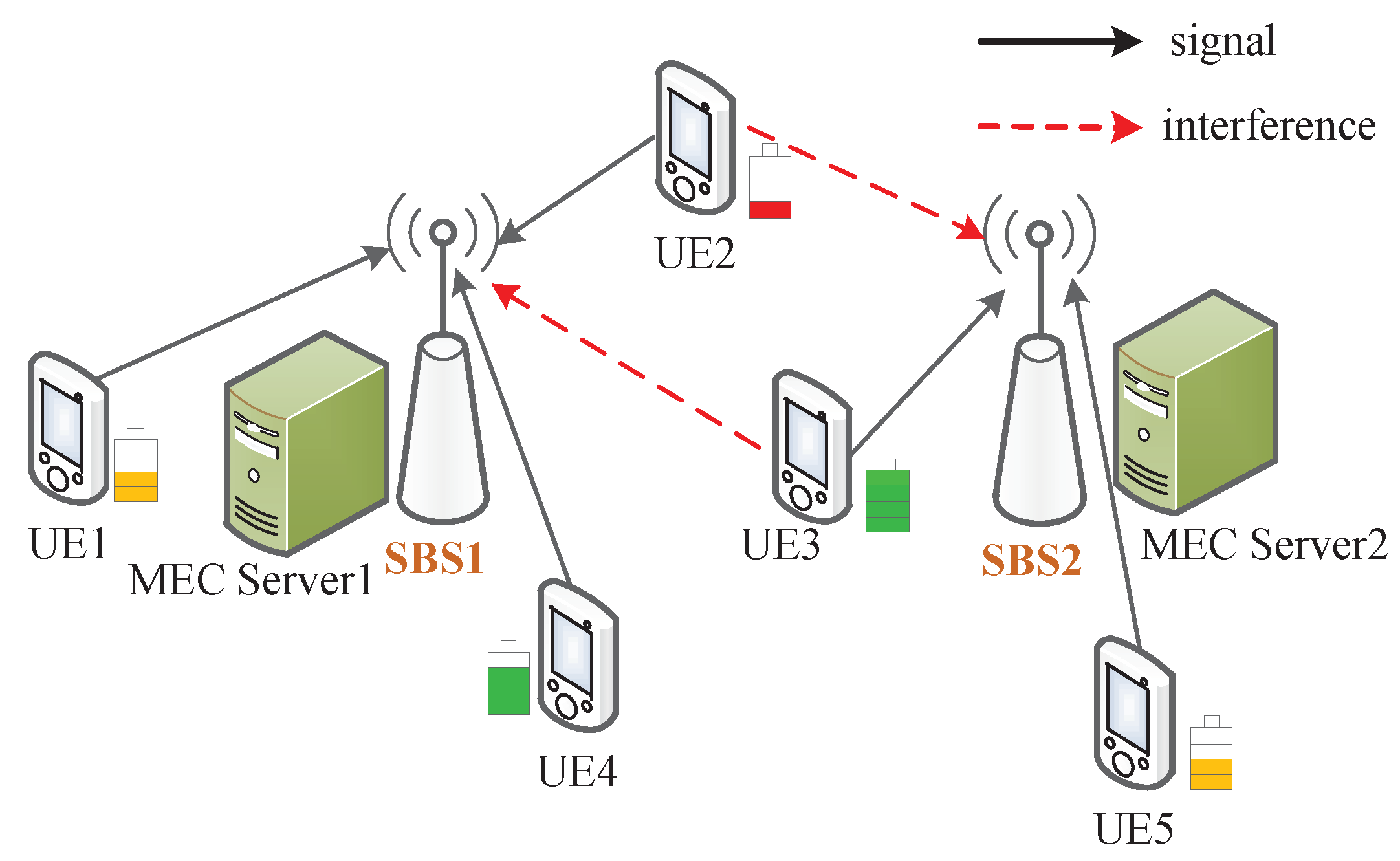


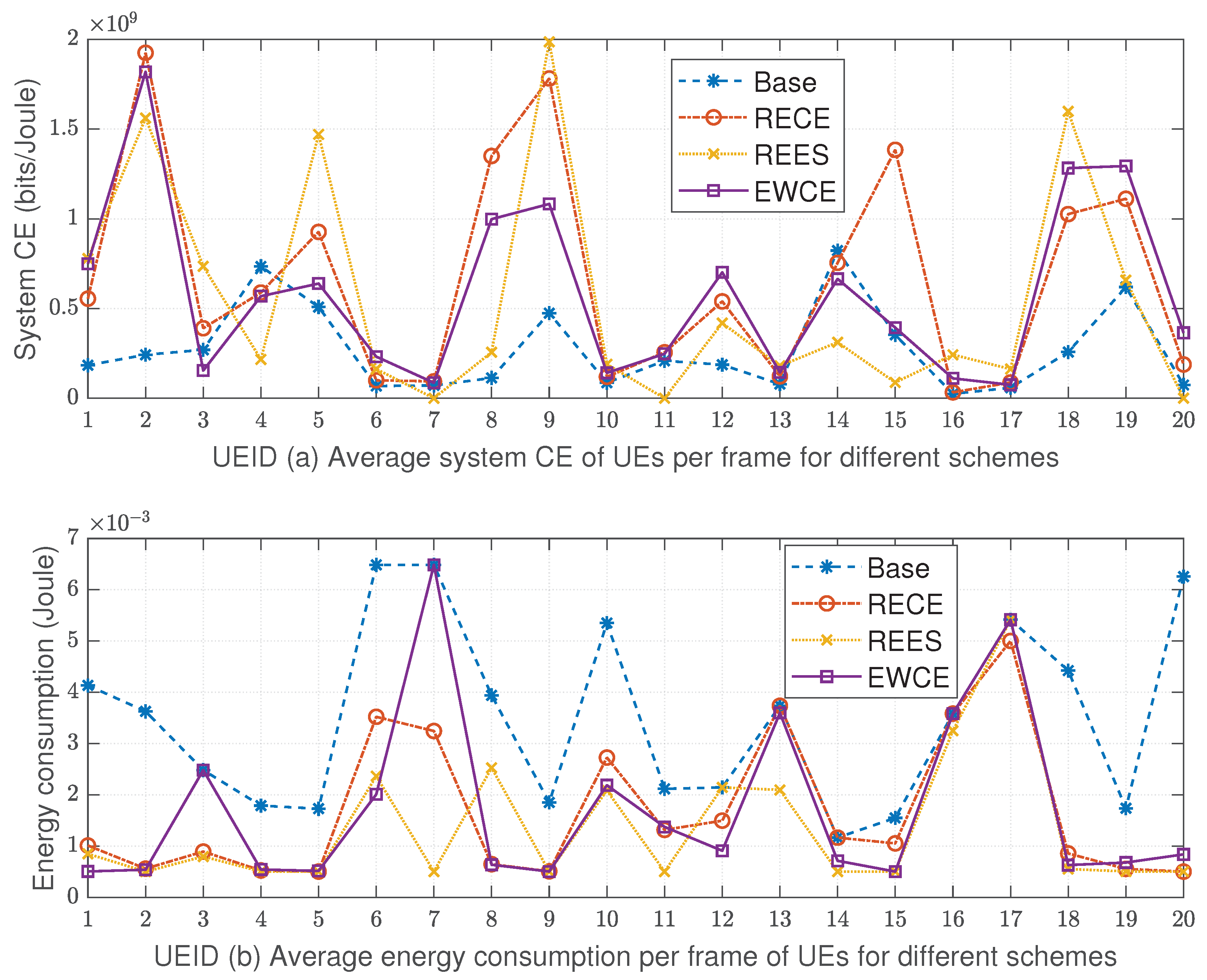
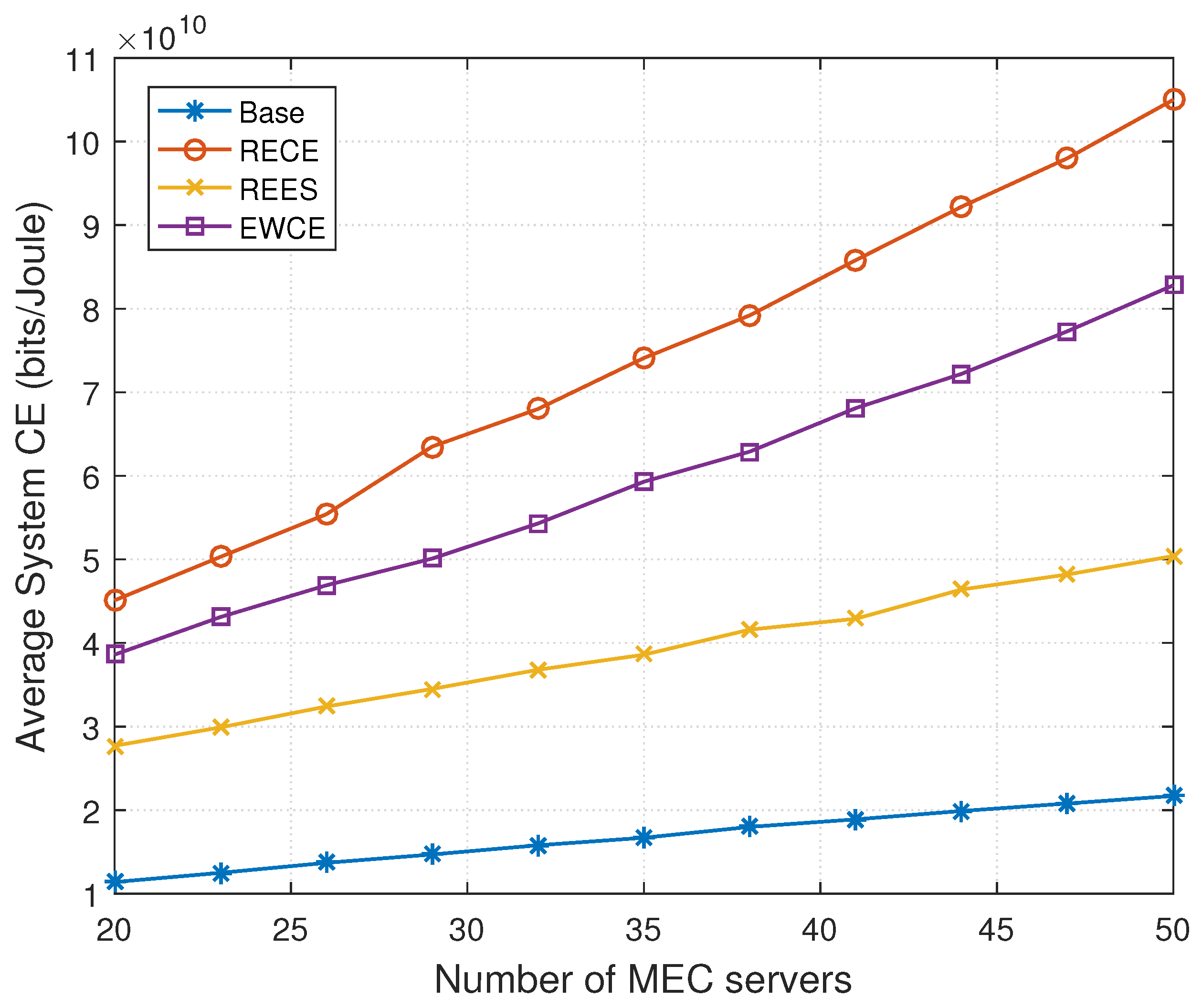
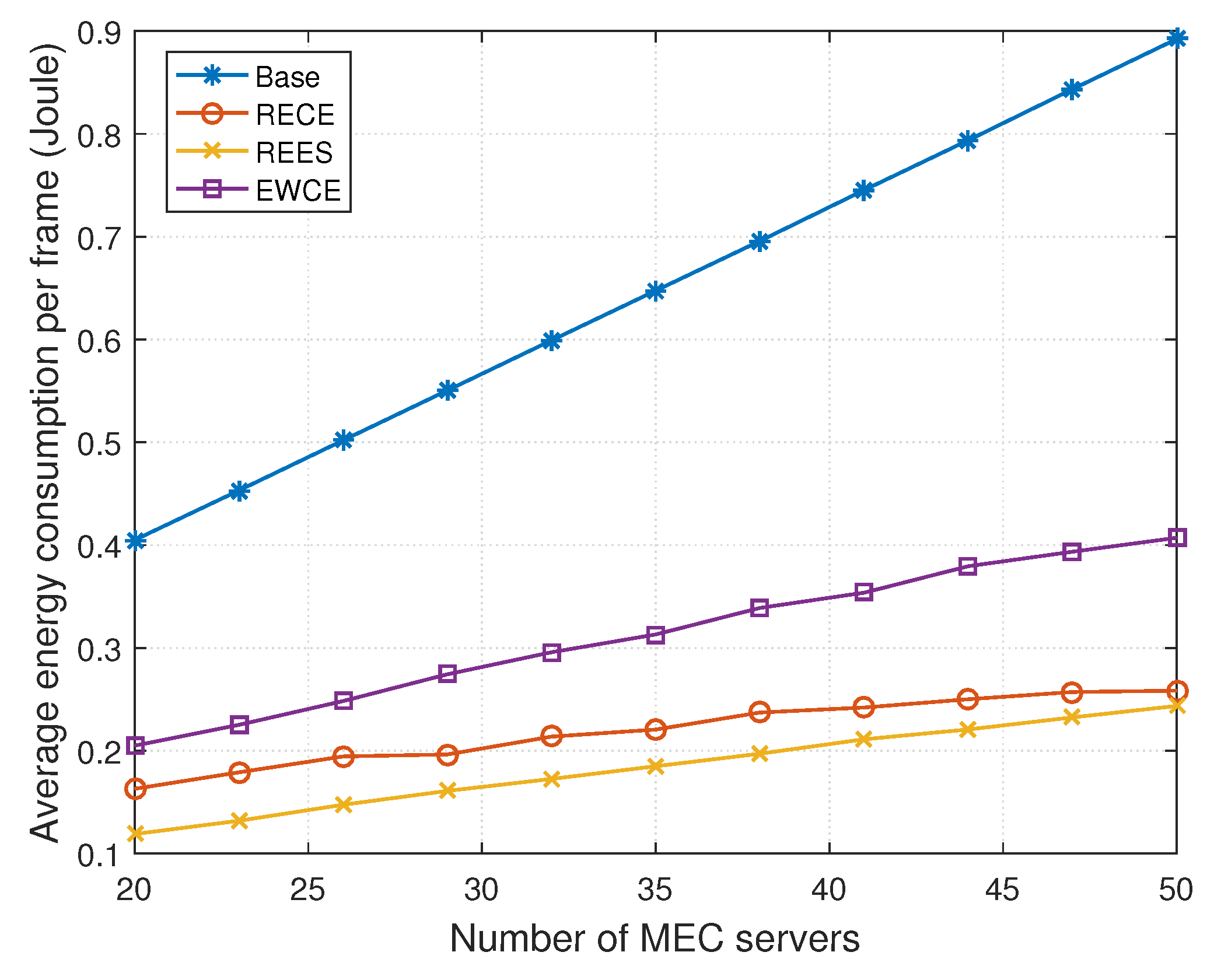
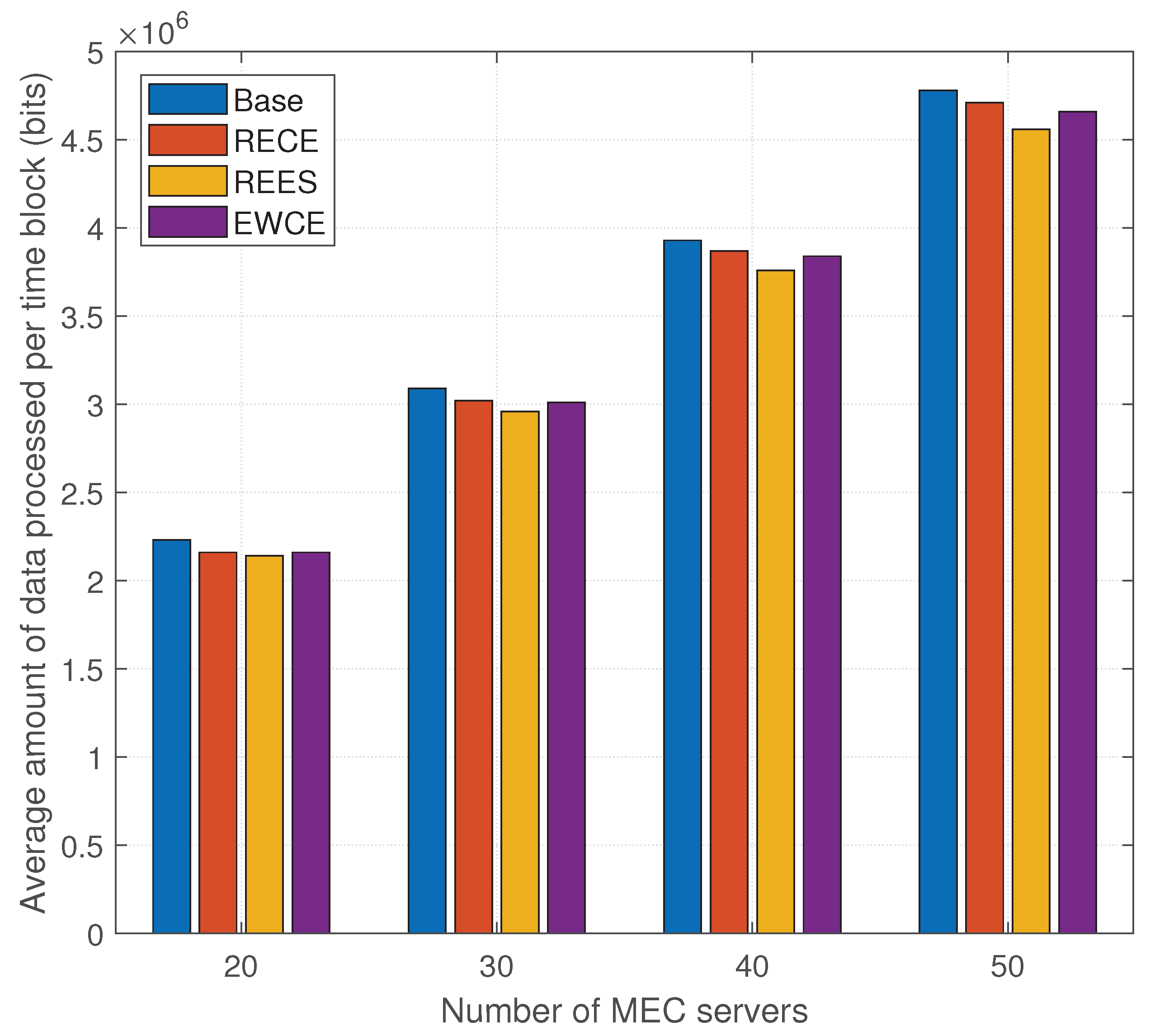
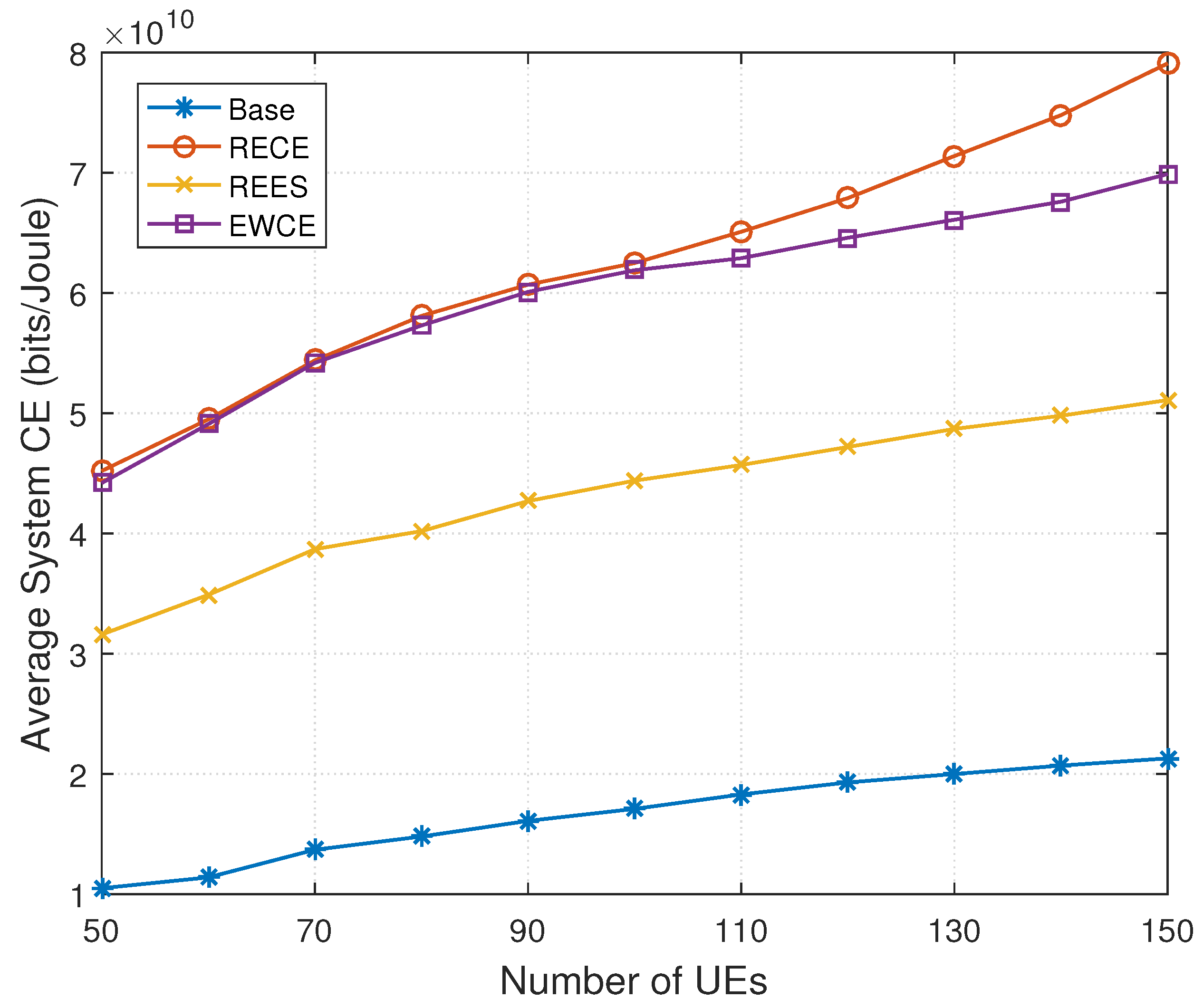
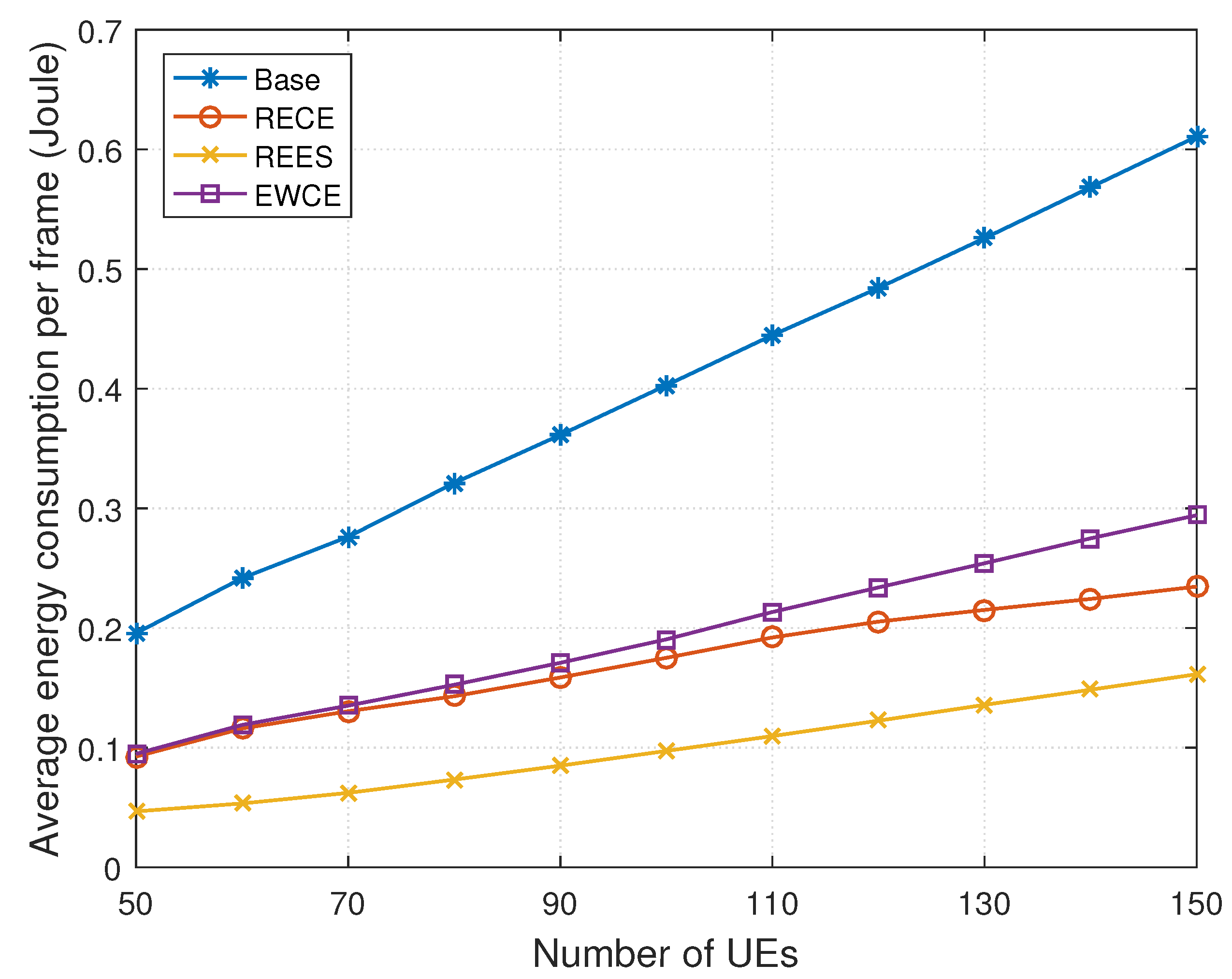

| Parameters | Value |
|---|---|
| Number of SBSs (MEC servers) S | 20∼50 |
| Number of UEs M | 50∼150 |
| Number of subchannels K | 5 |
| Bandwidth of each subchannel | 2 MHz [23] |
| Maximum transmit power of each UE | 23 dBm [37] |
| Amplifier coefficient | [23] |
| Transmit circuit power on each subchannel | W [23] |
| Minimum data rate of UE m | bits/s |
| Time block duration T | 10 ms |
| Noise power spectral density | dBm/Hz [25] |
| Maximum distance threshold | 10 m |
| UEID | 1 | 2 | 3 | 4 | 5 | 6 | 7 | 8 | 9 | 10 |
| Base | 0.18 | 0.24 | 0.27 | 0.73 | 0.51 | 0.07 | 0.07 | 0.11 | 0.47 | 0.09 |
| REES | 0.78 | 1.568 | 0.74 | 0.22 | 1.47 | 0.16 | 0.00 | 0.26 | 1.99 | 0.19 |
| EWCE | 0.75 | 1.82 | 0.15 | 0.57 | 0.64 | 0.23 | 0.09 | 1.00 | 1.08 | 0.14 |
| RECE | 0.56 | 1.93 | 0.39 | 0.59 | 0.93 | 0.10 | 0.09 | 1.35 | 1.78 | 0.12 |
| UEID | 11 | 12 | 13 | 14 | 15 | 16 | 17 | 18 | 19 | 20 |
| Base | 0.21 | 0.19 | 0.08 | 0.82 | 0.35 | 0.03 | 0.06 | 0.26 | 0.62 | 0.07 |
| REES | 0.00 | 0.42 | 0.18 | 0.31 | 0.09 | 0.24 | 0.16 | 1.60 | 0.66 | 0.00 |
| EWCE | 0.25 | 0.70 | 0.14 | 0.67 | 0.39 | 0.11 | 0.08 | 1.28 | 1.29 | 0.37 |
| RECE | 0.26 | 0.54 | 0.13 | 0.75 | 1.38 | 0.039 | 0.09 | 1.03 | 1.12 | 0.19 |
| UEID | 1 | 2 | 3 | 4 | 5 | 6 | 7 | 8 | 9 | 10 |
| Base | 4.13 | 3.63 | 2.48 | 1.79 | 1.73 | 6.49 | 6.49 | 3.94 | 1.85 | 5.35 |
| REES | 0.85 | 0.50 | 0.80 | 0.51 | 0.50 | 2.37 | 0.50 | 2.53 | 0.50 | 2.09 |
| EWCE | 0.51 | 0.54 | 2.48 | 0.54 | 0.52 | 2.01 | 6.49 | 0.64 | 0.51 | 2.19 |
| RECE | 1.02 | 0.56 | 0.89 | 0.53 | 0.50 | 3.52 | 3.25 | 0.65 | 0.51 | 2.73 |
| UEID | 11 | 12 | 13 | 14 | 15 | 16 | 17 | 18 | 19 | 20 |
| Base | 2.12 | 2.15 | 3.74 | 1.17 | 1.55 | 3.58 | 5.42 | 4.43 | 1.74 | 6.26 |
| REES | 0.50 | 2.15 | 2.10 | 0.50 | 0.50 | 3.25 | 5.42 | 0.55 | 0.51 | 0.50 |
| EWCE | 1.38 | 0.91 | 3.60 | 0.71 | 0.50 | 3.58 | 5.42 | 0.63 | 0.68 | 0.84 |
| RECE | 1.32 | 1.50 | 3.73 | 1.17 | 1.05 | 3.58 | 5.00 | 0.86 | 0.56 | 0.50 |
| S | 20 | 23 | 26 | 29 | 32 | 35 | 38 | 41 | 44 | 47 | 50 |
|---|---|---|---|---|---|---|---|---|---|---|---|
| Base | 11.36 | 12.49 | 13.71 | 14.72 | 15.79 | 16.73 | 18.04 | 18.85 | 19.86 | 20.80 | 21.67 |
| REES | 27.74 | 29.88 | 32.43 | 34.54 | 36.79 | 38.62 | 41.57 | 42.94 | 46.40 | 48.24 | 50.38 |
| EWCE | 38.57 | 43.06 | 46.93 | 50.11 | 54.28 | 59.32 | 62.92 | 68.07 | 72.23 | 77.26 | 82.83 |
| RECE | 45.15 | 50.30 | 55.42 | 63.48 | 67.98 | 74.14 | 79.15 | 85.83 | 92.25 | 98.01 | 104.77 |
| S | 20 | 23 | 26 | 29 | 32 | 35 | 38 | 41 | 44 | 47 | 50 |
|---|---|---|---|---|---|---|---|---|---|---|---|
| Base | 0.40 | 0.45 | 0.50 | 0.55 | 0.60 | 0.65 | 0.70 | 0.75 | 0.79 | 0.84 | 0.89 |
| REES | 0.12 | 0.13 | 0.15 | 0.16 | 0.18 | 0.19 | 0.20 | 0.21 | 0.22 | 0.23 | 0.24 |
| EWCE | 0.20 | 0.23 | 0.25 | 0.27 | 0.30 | 0.31 | 0.34 | 0.35 | 0.38 | 0.39 | 0.41 |
| RECE | 0.16 | 0.18 | 0.19 | 0.20 | 0.21 | 0.22 | 0.24 | 0.24 | 0.25 | 0.26 | 0.26 |
| M | 50 | 60 | 70 | 80 | 90 | 100 | 110 | 120 | 130 | 140 | 150 |
|---|---|---|---|---|---|---|---|---|---|---|---|
| Base | 10.47 | 11.40 | 13.68 | 14.79 | 16.09 | 17.15 | 18.35 | 19.34 | 20.00 | 20.72 | 21.32 |
| REES | 31.62 | 34.92 | 38.73 | 40.25 | 42.70 | 44.37 | 45.74 | 47.19 | 48.73 | 49.78 | 51.10 |
| EWCE | 44.16 | 49.08 | 54.22 | 57.29 | 60.07 | 61.87 | 62.92 | 64.61 | 66.10 | 67.59 | 69.91 |
| RECE | 45.21 | 49.48 | 54.22 | 58.13 | 60.74 | 62.54 | 65.07 | 67.92 | 71.40 | 74.81 | 79.07 |
| M | 50 | 60 | 70 | 80 | 90 | 100 | 110 | 120 | 130 | 140 | 150 |
|---|---|---|---|---|---|---|---|---|---|---|---|
| Base | 0.20 | 0.24 | 0.28 | 0.32 | 0.36 | 0.40 | 0.44 | 0.48 | 0.53 | 0.57 | 0.61 |
| REES | 0.05 | 0.05 | 0.06 | 0.07 | 0.08 | 0.10 | 0.11 | 0.12 | 0.14 | 0.15 | 0.16 |
| EWCE | 0.09 | 0.12 | 0.14 | 0.15 | 0.17 | 0.19 | 0.21 | 0.23 | 0.25 | 0.27 | 0.29 |
| RECE | 0.09 | 0.12 | 0.13 | 0.14 | 0.16 | 0.18 | 0.19 | 0.21 | 0.22 | 0.22 | 0.23 |
Disclaimer/Publisher’s Note: The statements, opinions and data contained in all publications are solely those of the individual author(s) and contributor(s) and not of MDPI and/or the editor(s). MDPI and/or the editor(s) disclaim responsibility for any injury to people or property resulting from any ideas, methods, instructions or products referred to in the content. |
© 2023 by the authors. Licensee MDPI, Basel, Switzerland. This article is an open access article distributed under the terms and conditions of the Creative Commons Attribution (CC BY) license (https://creativecommons.org/licenses/by/4.0/).
Share and Cite
Wu, S.; Li, X.; Dong, N.; Liu, X. Residual Energy-Based Computation Efficiency Maximization in Dense Edge Computing Systems. Electronics 2023, 12, 4429. https://doi.org/10.3390/electronics12214429
Wu S, Li X, Dong N, Liu X. Residual Energy-Based Computation Efficiency Maximization in Dense Edge Computing Systems. Electronics. 2023; 12(21):4429. https://doi.org/10.3390/electronics12214429
Chicago/Turabian StyleWu, Shie, Xiaolin Li, Ningfei Dong, and Xia Liu. 2023. "Residual Energy-Based Computation Efficiency Maximization in Dense Edge Computing Systems" Electronics 12, no. 21: 4429. https://doi.org/10.3390/electronics12214429
APA StyleWu, S., Li, X., Dong, N., & Liu, X. (2023). Residual Energy-Based Computation Efficiency Maximization in Dense Edge Computing Systems. Electronics, 12(21), 4429. https://doi.org/10.3390/electronics12214429






